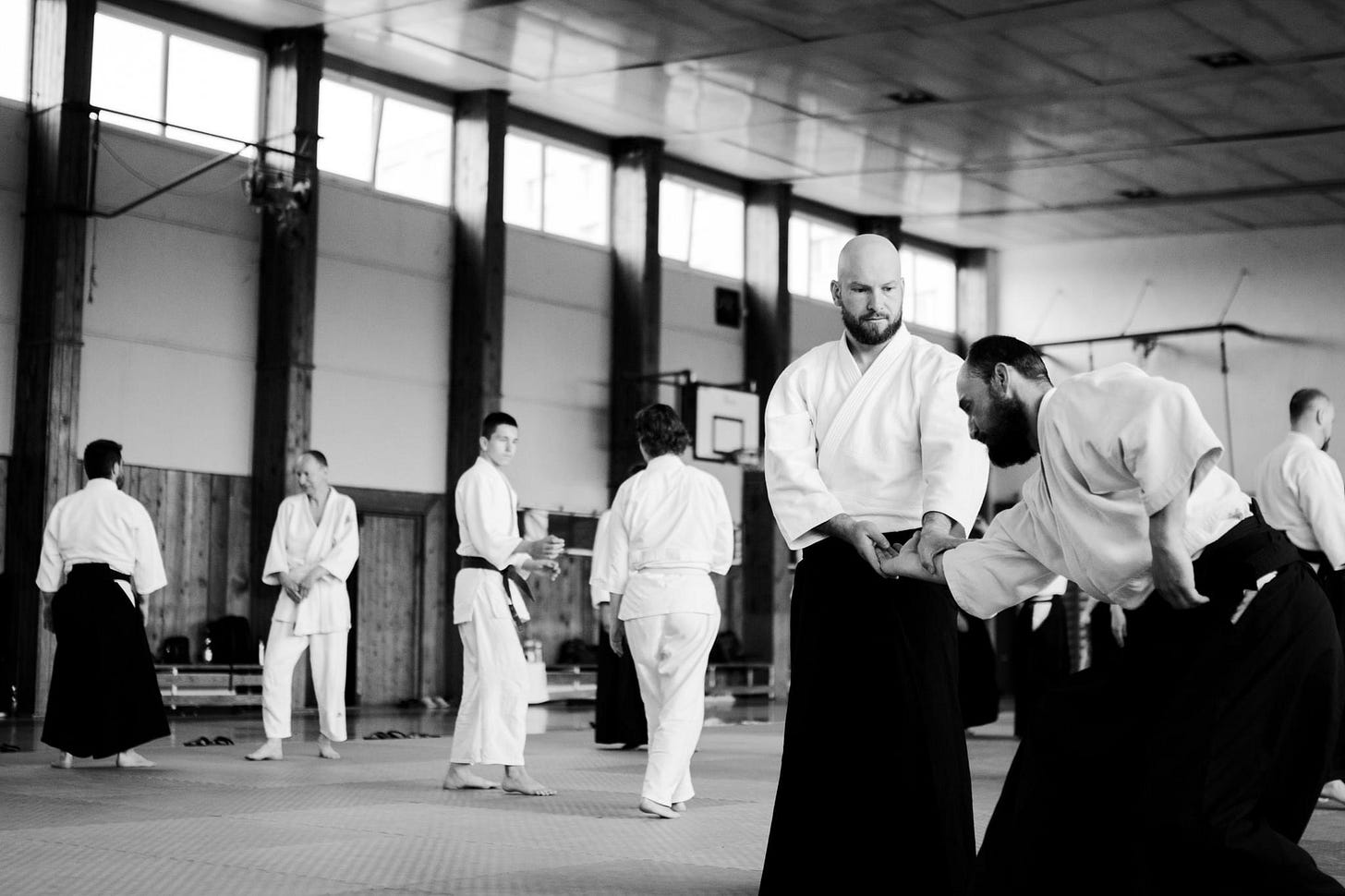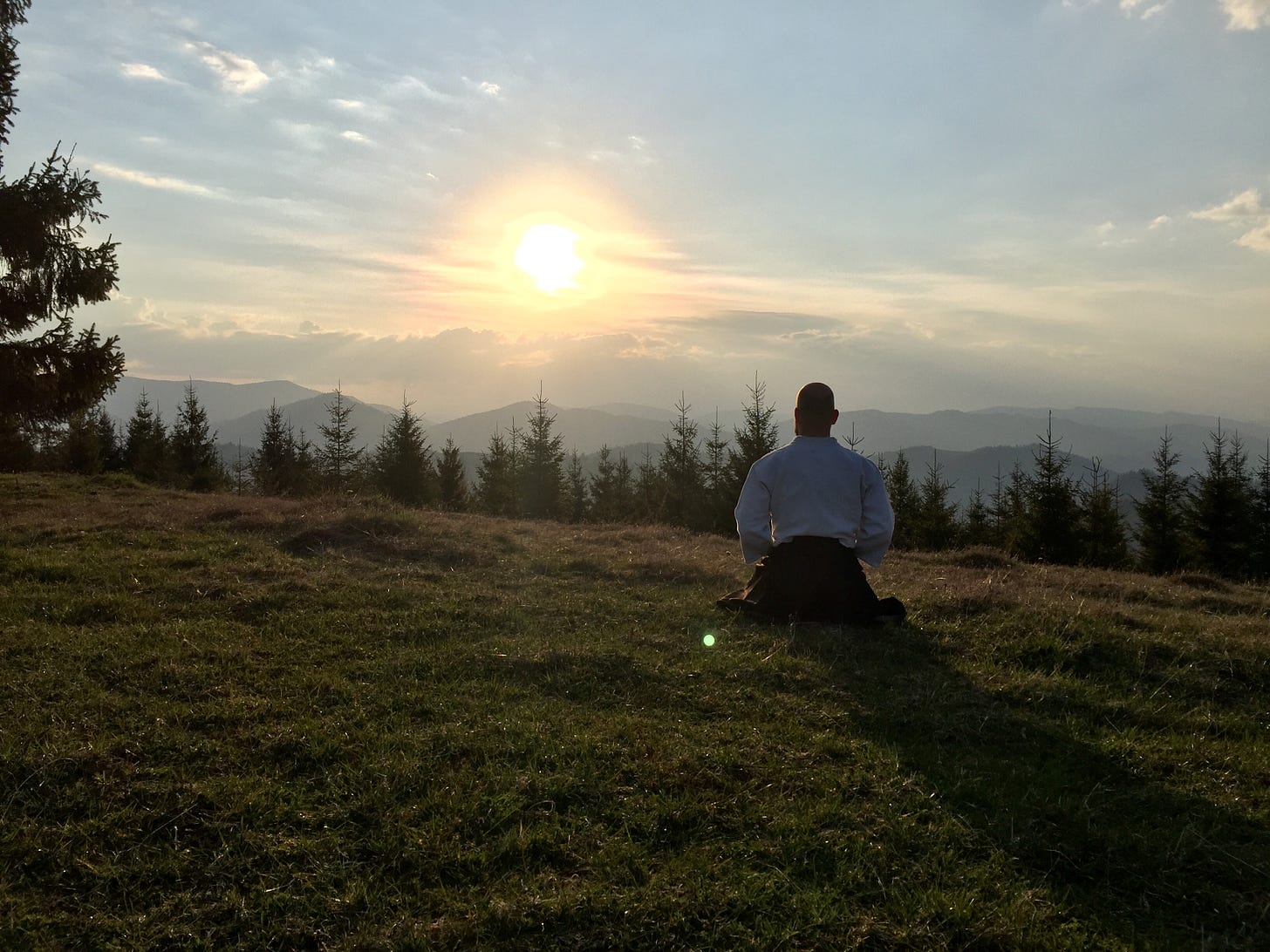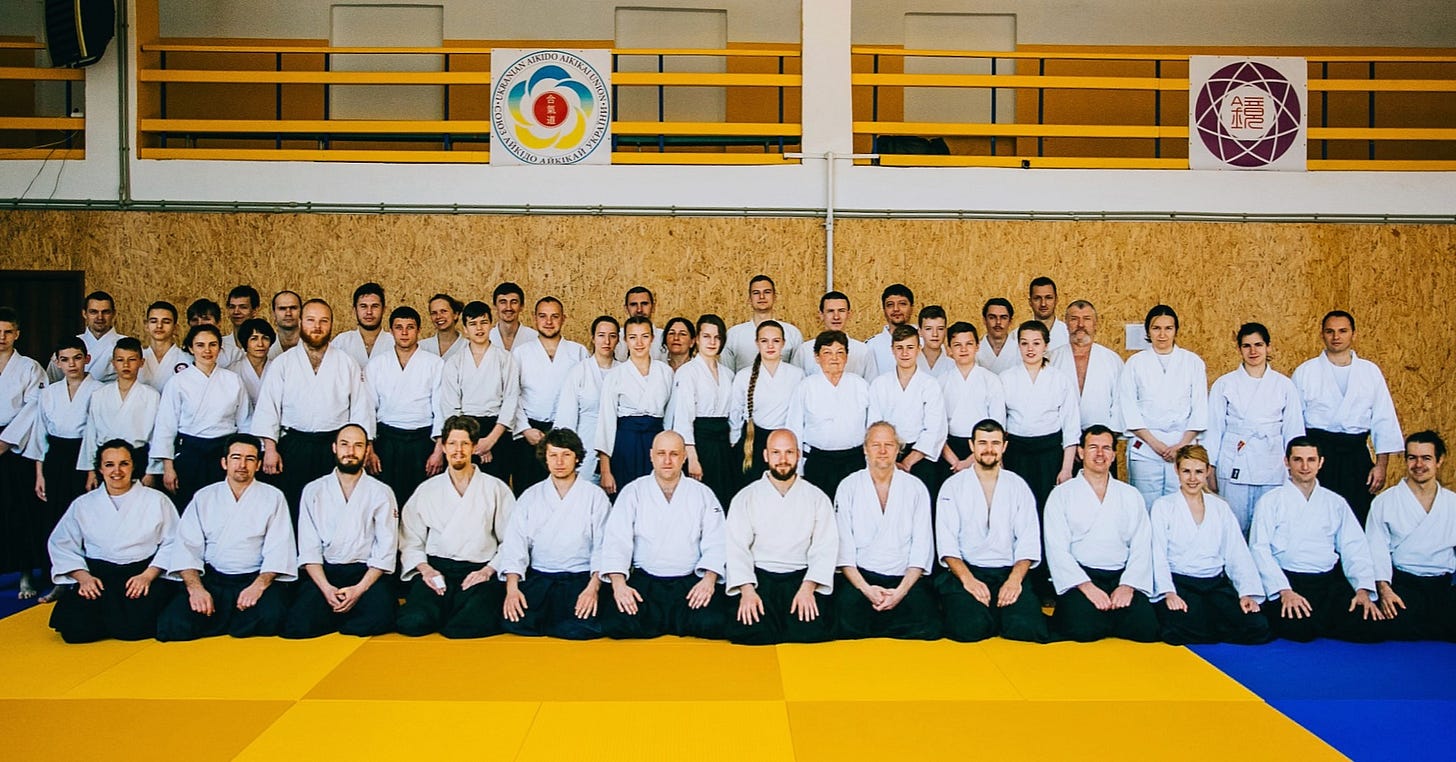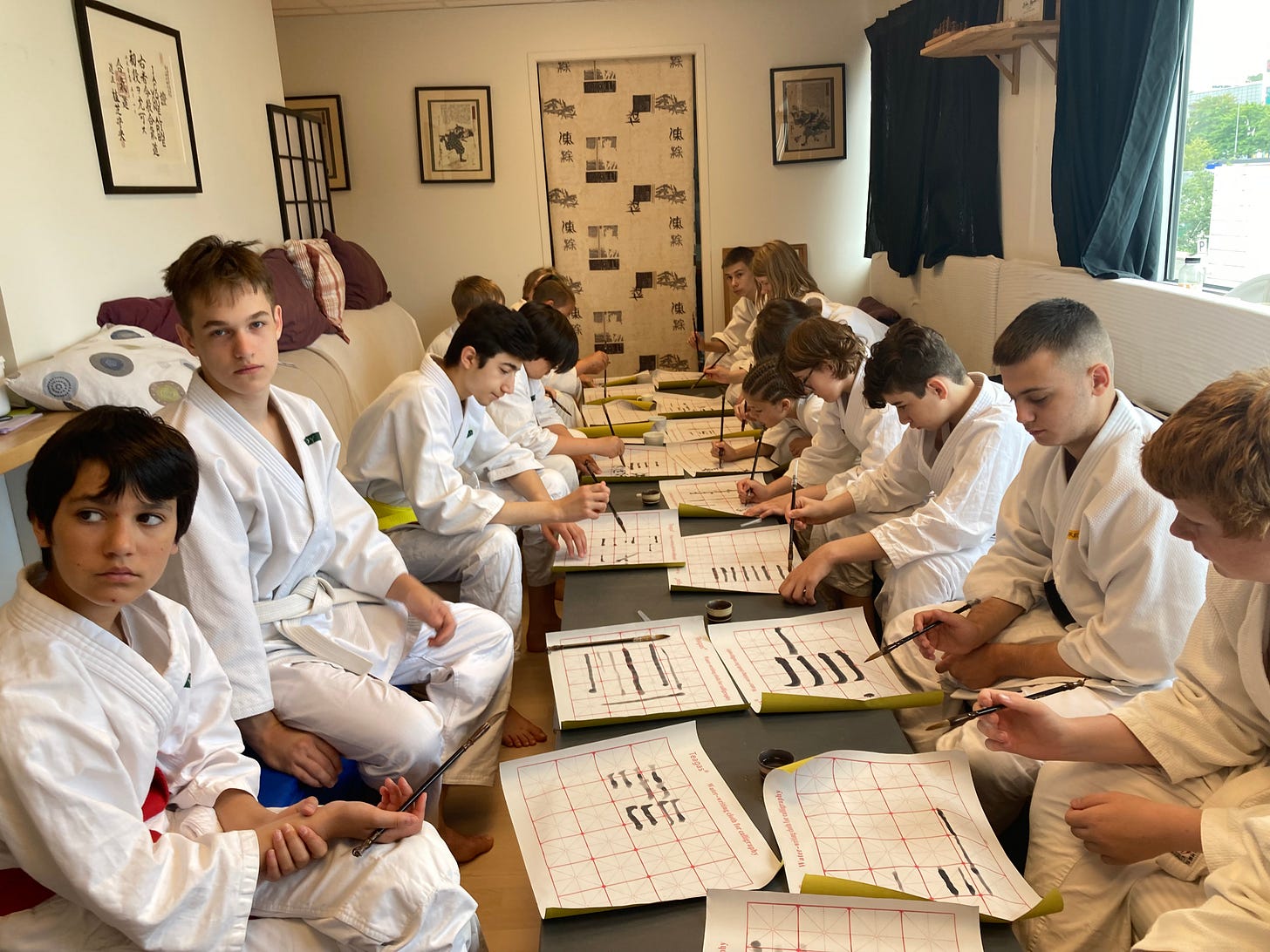Aikido Practice: More Than Meets the Eye
Exploring the Diverse Ways We Learn, Grow, and Contribute
Hello everybody!
Today, we’re sharing an article by Misha Rogach (4th dan), an Aikido teacher from Ukraine. You can find more about Misha and his work at the end of the text. For now, enjoy his perspectives:
Aikido is practice.
But what activities in Aikido can be considered practice?1
My journey as an Aikido teacher and dojo leader started at a very young, and I would say "tender", age. Because of this, I made a lot of mistakes. But, I wasn’t afraid to try out different methods and approaches to improve the dojo and help my students grow.
I was a professional Aikido teacher, and our dojo operated as a business. The way I taught and ran it directly affected my life.
This motivated me not just to survive but to constantly improve, compete with other businesses, and make the dojo a place where people could learn, practice, and grow. This required introducing new ideas, such as working with children and teenagers, handling media, and organizing everything. Over time, I learned to delegate, which allowed others to contribute and help develop Aikido.
As years passed, in my many conversations with friends, colleagues, and people who practice other martial arts, sports, and arts, I’ve found several "pillars" of my practice.
1. Practice in the Dojo
The main and most important part of every aikidoka’s journey is attending classes in the dojo. This is where the path usually starts. It is through regular training and hard work in the dojo we build our physical skills and lay the foundation we call kihon. Here, we get our first experience and start to see the door that leads to endless possibilities.
Practice in the dojo, in my opinion, will always be the main way to learn and grow in Aikido — whether you are a beginner, a club member, or a visitor who moves from dojo to dojo. Since Aikido is a lifelong path, the time we spend in the dojo changes throughout life. Sometimes we have more time for training, sometimes less. But we shouldn’t let this throw us off our journey.
There are other ways to keep growing, but we must remember that they work together rather than substitute for each other.
2. Personal Practice
Personal practice is anything we do on our own to improve ourselves. Growth can’t be limited to just what happens in the dojo.
Of course, this applies more to adults, but there are also children and teenagers who care about their progress and learning. We can work on our fitness (since Aikido is still a physical practice), suburi, breathing, flexibility, and so on. This approach really helps with progress, because without a partner, we have more time to focus on our individual qualities.
Personal practice can also include Midori-keiko—watching the training process. This might be for different reasons — perhaps you are recovering from an injury or just want to understand a technique better. It could also include watching videos, reading books, journaling, or reflecting on yourself.
I especially like the method of video analysis, which I borrowed from a close friend of mine, the head coach of the Ukrainian national snowboard team. His approach to training focused a lot on recording and analyzing techniques. This works in Aikido too.
3. Seminars
Seminars, master classes, gasshuku… are great way to learn from different teachers, exchange experience, and test your skills with people from different dojos and countries. I believe this plays an important social role in the Aikido world. It’s at seminars that new ideas, events, and projects are born. These events give us a chance to meet people of different levels and backgrounds, help beginners review the basics, and work with colleagues with similar skills.
Seminars can also be a challenging experience, exposing us to different cultures, environments, languages, climates, and training styles. In such cases, we practice adaptation and expand our horizons—which is Aikido practice, too.
For some people, especially at certain points in their lives, seminars provide a way to practice actively when attending a dojo is difficult. This is an opportunity to keep improving and not lose touch with Aikido.
4. Exams
This is a sensitive topic that brings up a lot of disagreement and discussion. But as long as Aikido has a ranking system, those with the right knowledge and experience will assess the progress of practitioners in one way or another. This is important because a person spends a lot of time working on themselves — physically, mentally, and socially.
All of this is reflected in exams. Even though exams can be controversial, I believe they are a useful and important part of a practitioner’s journey. They serve as milestones that show you are progressing, learning new things, and that the path continues.
5. Demonstrations
One aspect that is often underestimated, but is very important for more advanced students is demonstrations. They are not just performances, but a real way to grow and stay motivated. When you take part in a demonstration, you feel a sense of responsibility. It requires serious self-work. And what’s important, you can’t just "show off" — you need to do it at the highest level of your skills.
Demonstrations motivate beginners and remind experienced practitioners about the importance of quality in every detail. However, we must remember that demonstrations are just one part of Aikido. We don’t practice for the sake of performing — we practice to grow.
6. Teacher, Instructor, Assistant
Any role in facilitating the training process can be a great boost to your development. When you become a teacher or assistant, you need to carefully analyze your skills and abilities. You learn to explain things in simple words, break down movements, and put them together in a clear way.
One of my friends once said, "I explain things so much that I begin to understand them better myself." Teaching others helps you strengthen your knowledge. Another interesting point is that working with children not only helps advanced students to stay grounded in the basics but also to stay focused on simple solutions, and to make complex things feel more manageable.
7. The Development and Spread of Aikido
Designers, videographers, photographers, managers, IT specialists, bloggers — can they all be considered practitioners of Aikido? Absolutely! These people may not practice on the tatami, but they help Aikido reach other areas of life. Their work is another form of practice, allowing Aikido to expand outside the dojo and be seen by more people. In this way, Aikido becomes not just a martial art but a cultural phenomenon that has an impact on society.
If we practice Aikido and also contribute to its development using other arts or crafts, we enrich our Aikido experience and find new ways of personal expression.
And Mixing them Together
The challenge for each of us is to combine these elements in a unique way that suits our needs. We need to practice, combine different approaches, and try new things.
The goal is simple — to learn and develop as a human being. And also, to help Aikido continue to grow, inspire others, and share everything we love about this art.
For example, when I realized we needed to focus on media in our dojo, we started filming our classes, and trips, making promotional videos, and so on. It was eye-opening to see how much unnecessary content we were creating. During editing, I had to cut out large parts of the videos—slow movements, lack of focus, shifting weight, scratching my head—because they didn’t add value. It wasn’t easy to see myself like that, but as we know, the camera only shows what we do. This helped improve our Aikido practice because we began to use new methods and approaches.
Don’t be afraid to try, make mistakes, and experiment. Don’t turn down anything that could help you and your students become better.
What are your favorite parts of Aikido practice? Would you add something to the list above?
About author
Misha Rogach, 4th dan Aikikai, is an Aikido teacher originally from Uzhhorod, Ukraine, currently living in Slovakia.
He founded Kagami Dojo for children, teenagers, and adults in 2004. He is also a co-founder and leader of the Aikido Aikikai Academy in Uzhhorod—an association dedicated to uniting clubs and instructors for the study, development, and practice of Aikido.
His main inspirations and influences: Stefan Stenudd, Stéphane Benedetti, Nebi Vural, Takanori Kuribayashi, Zdenko Reguli, and Bruno Gonzalez.
His Aikido practice emphasizes precision, efficiency, and clarity in technique and movement.
Misha also trains in Brazilian Jiu-Jitsu.
I won’t go into the methods of Keiko, as explained by Tamura sensei in his great books. However, I suggest you reread them and think about them — I’m sure it will make your training better and more enjoyable. After all, Aikido is so rich and deep.









Thanks Misha for your article - I appreciate your thoughtful perspective on the breadth of what practice is. As I reflect on your article, the question arises for me, "What am I practicing for?" when I train on the mat, at home, in a seminar, when I volunteer to teach at our kids class, when I prepared for my black belt test. One of the challenges I think that we can face in aikido practice is that so much can be held as practice. Mary Heiny Sensei said in the last seminar I attended - "everything is practice". Too often practice discussions become debates about what practice is best. What I notice over time is that what I need to practice now to grow and develop changes.
In the intense lead up to my black belt test, I found a focus on refining details and home practice to repeat techniques to "wire" them into my system were a necessary, alchemical process to refine kihon. Now, I can make use of that grinding practice work to focus on other practice goals.
What I am finding helpful in any kind of practice is to set an intention about my purpose for practice in any of the practice contexts so I can focus on my purpose and notice changes and assess whether more work is needed or whether it is time to shift focus onto something else. It is one way of being with the sheer complexity of what is included in aikido practice.